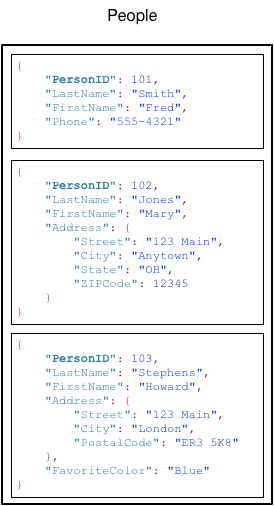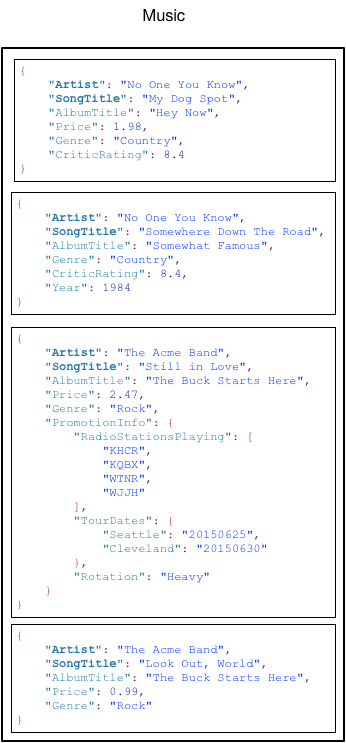Table of Contents
What is NoSQL
- NoSQL databases are non-tabular databases and store data differently than relational tables
- NoSQL databases store data in documents (ex: json) rather than relational tables
- NoSQL databases do not support join
- NoSQL databases scale horizontally
- Benefits of NoSQL Databases
- Flexible data models
- Horizontal scaling
- Faster queries
- Easy to work
NoSQL Database
- Most-popular types of NoSQL database
- Document databases
- Key-value stores
- Wide-column databases
- Graph databases
- Popular NoSQL Databases
- MongoDB
- Couchbase
- Redis
- Amazon DynamoDB
- IBM Cloudant
- RavenDB
- Cassandra
- HBase
- Azure Cosmos DB
Amazon DynamoDB
- Amazon DynamoDB is a fully managed, serverless, key-value NoSQL database designed to run high-performance applications at any scale.
- Single-digit millisecond performance at any scale
- Millions of requests per seconds, trillions of row, 100s of TB of storage
- Each table has a primary key
- Each table can have an infinite number of items
- Maximum size of a item is 400KB
- Data types supported are:
- Scalar Types: String, Number, Binary, Boolean, Null
- Document Types: List, Map
- Set Types: String Set, Number Set, Binary Set
Components of Amazon DynamoDB
- The core components of DynamoDB are tables, items, and attributes
- A table is a collection of items, and each item is a collection of attributes.
- DynamoDB uses primary keys to uniquely identify each item in a table and secondary indexes to provide more querying flexibility.
- Tables: A table is a collection of data. DynamoDB stores data in tables.
- Items: Each table contains zero or more items. An item is a group of attributes that is uniquely identifiable among all of the other items.
- Attributes: Each item is composed of one or more attributes. An attribute is a fundamental data element, something that does not need to be broken down any further.


DynamoDB – Primary Keys
- When you create a table, table name and the primary key will be given.
- The primary key uniquely identifies each item in the table, so that no two items can have the same key
- DynamoDB supports 2 types of primary keys
- Partition key
- A simple primary key, composed of one attribute known as the partition key
- Partition key and sort key
- A composite primary key, composed of two attributes. partition key and sort key.
- The combination must be unique
- Partition key
DynamoDB – Provisioned Throughput
- Table must have provisioned read and write capacity units
- Read Capacity Units (RCU): throughput for reads
- Write Capacity Units (WCU): throughput for writes
- Option to setup auto-scaling of throughput to meet demand
- ReadCapacityUnits
- The maximum number of strongly consistent reads consumed per second
- WriteCapacityUnits
- The maximum number of writes consumed per second
DynamoDB – Write Capacity Units
- One write capacity unit represents one write per second for an item up to 1 KB in size.
- If the items are larger than 1 KB, more WCU are consumed
- Example 1: we write 10 objects per seconds of 2 KB each.
- We need 2 * 10 = 20 WCU
- Example 2: we write 6 objects per second of 4.5 KB each
- We need 6 * 5 = 30 WCU (4.5 gets rounded to the upper KB)
- Example 3: we write 120 objects per minute of 2 KB each
- We need 120 / 60 * 2 = 4 WCU
DynamoDB – Read Capacity Units
- One read capacity unit represents one strongly consistent read per second, or two eventually consistent reads per second, for an item up to 4 KB in size.
- If the items are larger than 4 KB, more RCU are consumed
- Example 1: 10 strongly consistent reads per seconds of 4 KB each
- We need 10 * 4 KB / 4 KB = 10 RCU
- Example 2: 16 eventually consistent reads per seconds of 12 KB each
- We need (16 / 2) * ( 12 / 4 ) = 24 RCU
- Example 3: 10 strongly consistent reads per seconds of 6 KB each
- We need 10 * 8 KB / 4 = 20 RCU (we have to round up 6 KB to 8 KB)
DynamoDB – Write, Delete Data
- PutItem – Write data to DynamoDB
- UpdateItem – Update data in DynamoDB
- DeleteItem
- Delete an individual row
- Ability to perform a conditional delete
- DeleteTable
- Delete a whole table and all its items
- Much quicker deletion than calling DeleteItem on all
DynamoDB – Batching Writes
- BatchWriteItem
- Up to 25 PutItem and / or DeleteItem in one call
- Up to 16 MB of data written
- Up to 400 KB of data per item
- Batching allows you to save in latency by reducing the number of API calls done against DynamoDB
- Operations are done in parallel for better efficiency
DynamoDB – Reading Data
- GetItem:
- Read based on Primary key
- Primary Key = HASH or HASH-RANGE
- Eventually consistent read by default
- Option to use strongly consistent reads (more RCU – might take longer)
- ProjectionExpression can be specified to include only certain attributes
- BatchGetItem:
- Up to 100 items
- Up to 16 MB of data
- Items are retrieved in parallel to minimize latency
Amazon DynamoDB Accelerator (DAX)
- It is a fully managed, highly available, in-memory cache for Amazon DynamoDB that delivers up to a 10 times performance improvement—from milliseconds to microseconds—even at millions of requests per second.
- DAX does all the heavy lifting required to add in-memory acceleration to your DynamoDB tables, without requiring developers to manage cache invalidation, data population, or cluster management.
Amazon DynamoDB